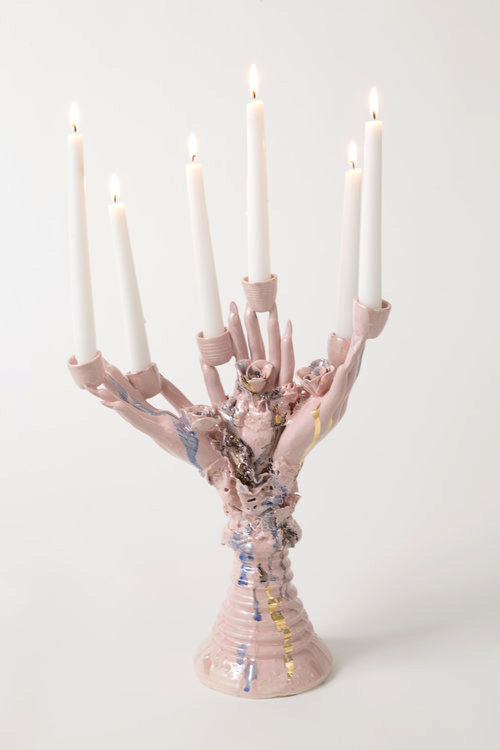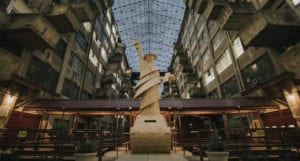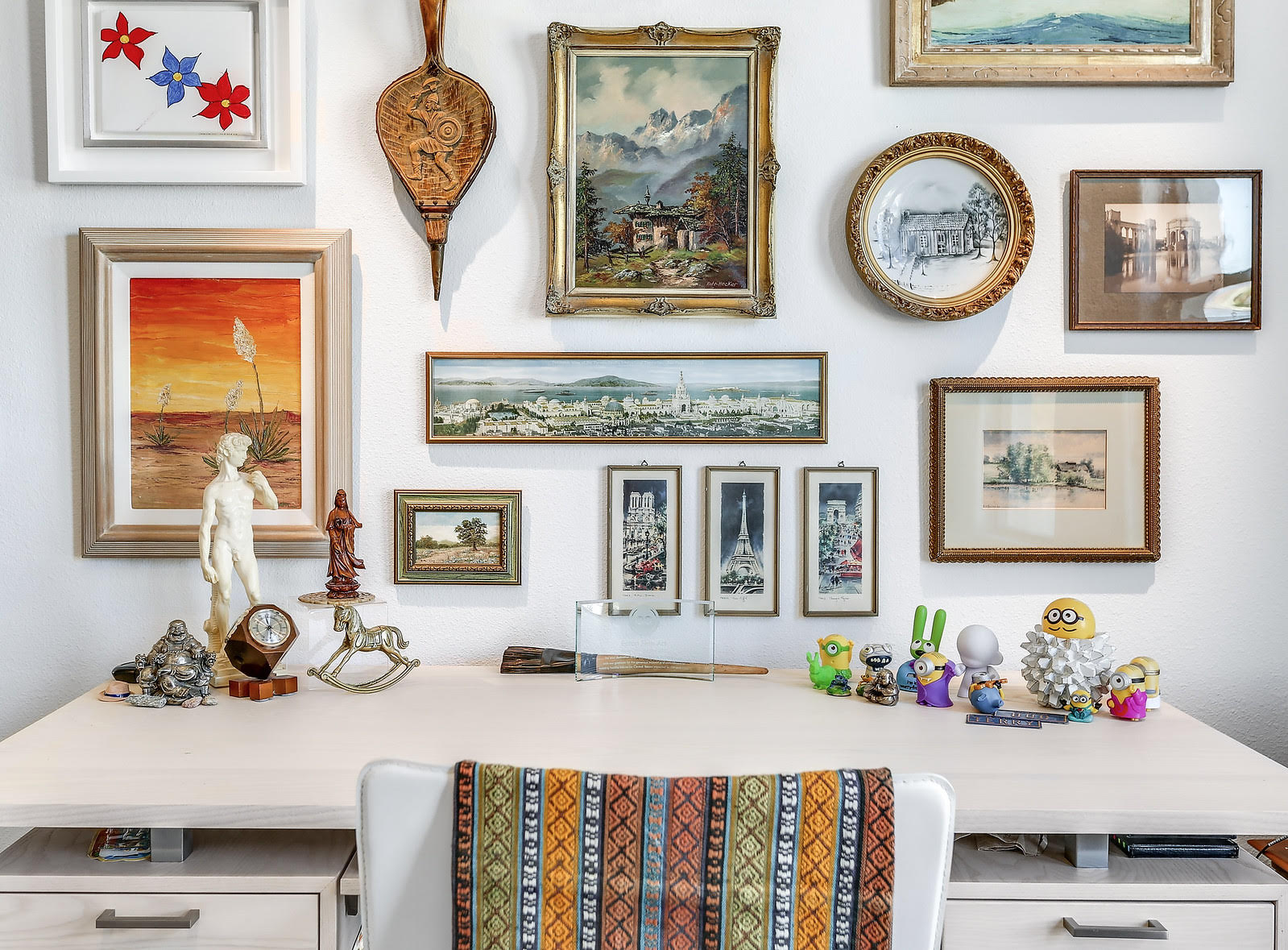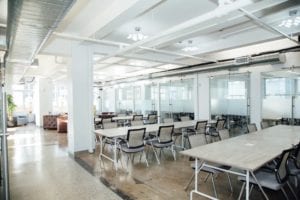The L line may be shutting down, but luckily it won’t happen before you check out Jen Dwyer’s debut solo exhibition at Lucas Lucas, a new East Williamsburg gallery and event space. ‘Not for You, Bunny’, opens Thursday October 18th and will feature Dwyer’s assortment of candelabras, mirrors, and vases from her “War Paint” and “Blind Spot” signature series.
We caught up with Dwyer to discuss her background, the history of ceramics, and how the Rococo art movement inspired her latest body of work.
Art Zealous: Hometown?
Jen Dwyer: I grew up a small town, San Anselmo, outside of San Francisco
AZ: Background?
JD: I’m currently a graduate student in my third year of a three-year degree program at the University of Notre Dame, pursuing an MFA in ceramics. I fell in love with art in high school, but it wasn’t until my last year of high school that I took an art class and simultaneously was tested for learning disabilities when I was studying for the SATS. It turns out I have both a learning and reading disability. Art was the first class I took that I was able to work hard and excel, unlike my academic classes, where I often felt I had to work twice as hard as most my peers for only decent grades. In college, I was a collegiate rower and pursuing a double degree in environmental science and art. I did so much in college, but once I graduated I finally had the head space to think clearly about what I wanted to do and I found something really special about art-coming up with an idea and creating it yourself from start to finish.

AZ: You create “socially engaged ceramic sculptures,” and given our current political climate, do you find creating these works cathartic or the important for artists to give their much-needed perspective? A little bit of both?
JD: Yes, definitely feels like a bit of both. Art and particularly ceramics feels like both a personal and collective healing tool. The restorative quality of clay was one of my initial interests in clay. Pottery has a rich history of being used as a therapeutic tool, particularly in the United States. After World War II, it was used to help acclimate Veterans back into civilian life. The tactile and communal experience of clay, which is very different from the solitude practiced in most art forms, served to be very helpful in their recovery. I think about the unique history and aspect of ceramics in my own practice.
AZ: Have you ever experimented with mediums outside of ceramics?
JD: Yes, I studied art and environmental science in undergrad and was a collegiate rower, so my time in college didn’t afford me much time to experiment. However, for the three years after college, I played around with any medium I could get my hands on. I had a two-year love affair with photography and printmaking.I dabbled in recycled materials and drawing, performance art and video. Today, I find that ceramics and more recently painting are the two mediums I am able to best express ideas, research and thoughts.
AZ: In your body of work “War Paint,” and “Let’s Eat Cake,” the Rococo period was a major influence and that the “goal for this work is to create a utopic space that blurs the barriers between the private and public, subject and object, and self and other.” Coincidentally, during that time period people were ignoring the warning signs of a system out of balance aka the French Revolution. Did that play into your work at all? Was that something that came to mind during your process?
JD: Yes definitely, although much of my work is focused on gender politics, I definitely think about consumerism and high/ low brow culture and the parallels between the 18th c. Western Europe, including the French Monarchy, and our own political climate. I certainly see some of my Rococo infused pieces as objects that could reference moments before the crash.
Today, we may think of porcelain as simply desirable or collectible, but in the 18th-century porcelain was known as ‘white gold’ and was one of the most valuable commodities in the world, more precious than real gold. It was developed in China around 2,000 years ago, but the method for making this pure white clay body remained a mystery to Europeans until the early 18th-century when an alchemist named Johann Friedrich Böttger claimed to have discovered the formula.
Although I reference the French Rococo aesthetic, I’m interested in all the history of porcelain in Western Europe- beginning with Augustus the Strong, Polish King, whose desire for the material drove him to imprison a talented young alchemist in hopes of finding the formula. Those whose glory days were made possible by exploiting the underclass inevitably came to a righteous end, including August the Strong, who among his treasure trove, was passionate about porcelain. In the end, his opulence rendered him nearly penniless. August the Strong died poor, yet surrounded by thousands of porcelain objects, unable to afford the dreamed-of palace in which to house them. Such a story is epic, but self-indulgence is not unique to kings. It occurs in the much more intimate scale of the everyday.
One element of my current art practice is based on the concept of historical amnesia, art created as objects of cultural memory. Throughout history, people have turned to decadence: objects of comfort, activities of pleasure and consumption, to deny and escape their inevitable fate, death. The idea of opulence and decadence, through the lenses of excessive ornate 18th-century Rococo aesthetics, is a classic example of this impulse, one that is important for our understanding of ourselves and the current social climate.

AZ: Besides the Rococo time-period, do you have other strong influences in your life?
JD: Yes, I definitely draw from an amalgamation of references- from pop culture, Greek mythology, Mission school artists, and contemporary girlhood culture.
AZ: In your artist statement you mention: “My decorative quasi-functional sculptures offer a remixed interpretation of utopia.’ What is your personal utopia?
JD: California 🙂 I grew up in the Bay Area, although I haven’t lived there in over a decade, so perhaps at this point I’ve put it on such a pedestal that it could never live up to my idea of it, haha. But anywhere warm, with nature and yoga seems like a Utopian landscape to me.
AZ: Talk to us about your upcoming solo show “Not for you, Bunny’ at Lucas Lucas Gallery.
JD: I’m really excited. It will be my first solo exhibition, so I’m a little nervous, but really excited. It’s co-curated by Stacie Lucas and Nathalie Levey opening Oct 18th from 6-9pm. I’ve been continuously working on these Rococo, quasi-functional sculptures influenced with pop culture and greek mythology references for a little over a year so I’m looking forward to see all the pieces together in the Lucas Lucas gallery. I haven’t shown my gilded mirror pieces to wide audience yet, so I’m excited to see how the viewers will interact with them and see how my audiences body become apart of the piece and essentially finish the piece.

AZ: What do you hope viewers take away from the exhibition?
JD: In general -aim to create a blurred headspace where notions of taste, beauty, and quality and gender are confused. More specifically my research also stems from self-representation and agency. I don’t want my females to be props or ornaments—they’re active participants in their world with their own complicated narrative. I’m interested in the ways the mirrors can create space for a wider audience to engage with self-representation.
AZ: How can we stay in touch?
JD: I’m most active on Instagram @jen_dwyer_ and my website if www.jen-dwyer.com



